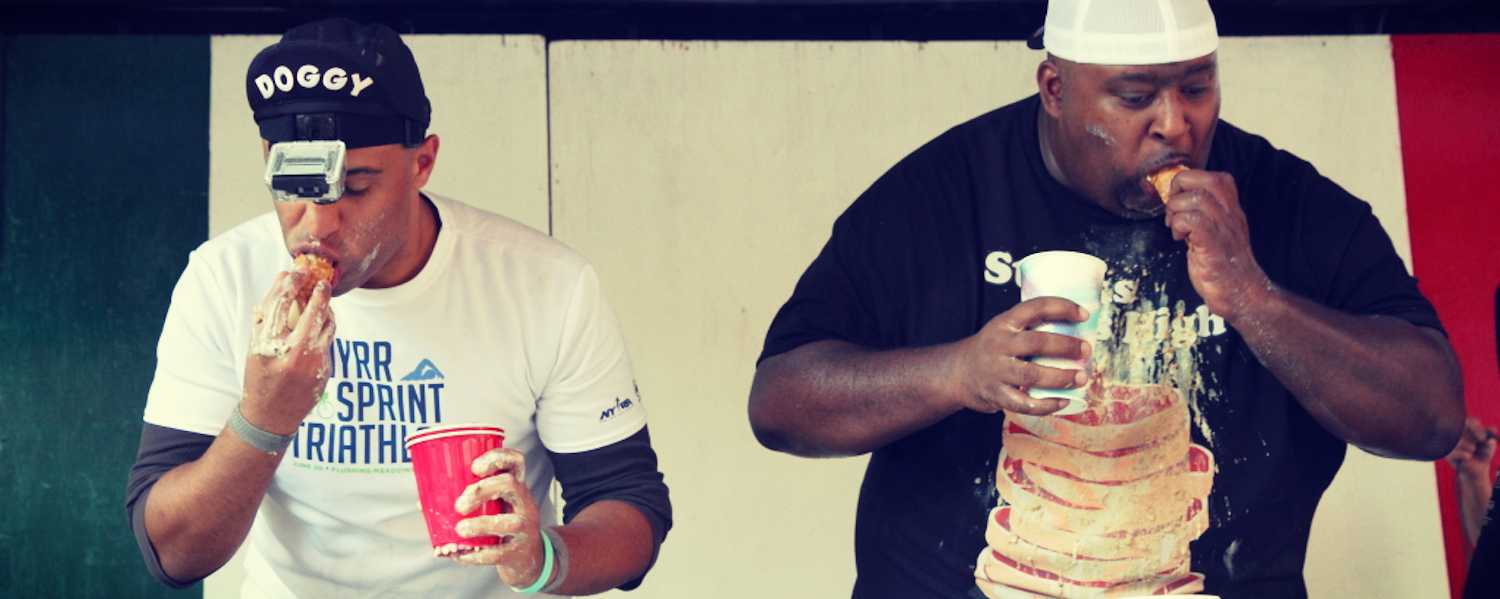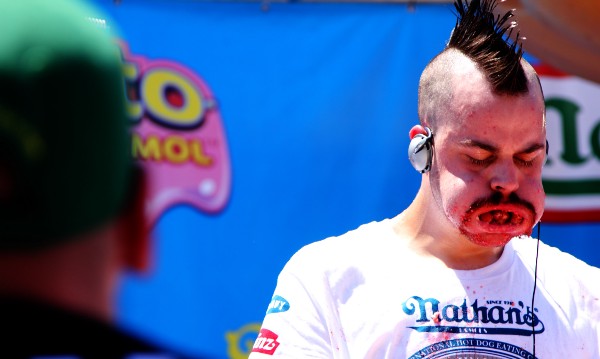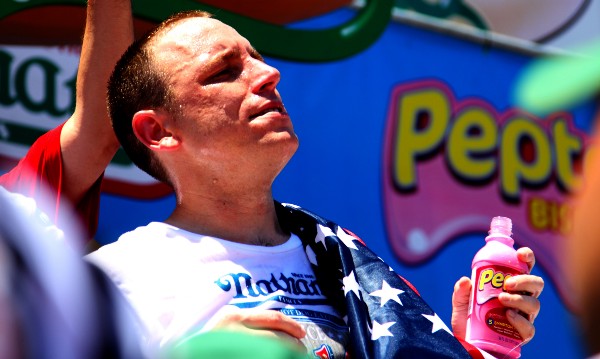

Every year on July 4, competitors converge on Coney Island in New York City for Nathan’s Famous Hot Dog Eating Contest. The goal is to scarf down as many wieners and buns as possible in front of a crowd of 40,000 people. The contest has been running since 1972 and is now something of an Independence Day fixture–it’s broadcast nationally by ESPN, and up to two million people tune in to marvel at the gastrointestinal abilities on display. The winner’s prize is glory, money, and a mustard-colored belt.
Joey “Jaws” Chestnut, the world’s highest-ranked player according to Major League Eating–the professional body that sanctions more than several dozen events annually–got through 70 hot dogs in 10 minutes this year. He regained the crown he had lost in 2015 to his fiercest rival, Matt “The Megatoad” Stonie, and picked up a $10,000 check for his efforts.
Competitive eating is serious business. Chestnut can reportedly make around $200,000 a year through competitions, personal appearances, and endorsements. But earning big bucks is rare, and these contests certainly aren’t a place for wannabes. In 2003, former NFL player William Perry entered Nathan’s as a celebrity contestant and pulled out after only managing four hot dogs in five minutes. This is unsurprising. Competitive eaters are consistently pushing the boundaries of the human body’s capability to carry and absorb food.

Yasir Salem is a marketing director in the publishing industry. He’s also ranked ninth in the world at competitive speed eating–something that he began doing after watching a broadcast of Nathan’s in 2008 on ESPN. He placed seventh at this year’s contest (consuming 31 hot dogs in 10 minutes), so he’s got a real stomach, but he’s also a well-oiled machine. Salem regularly competes in Ironman events and loves cycling. He’s probably in better shape than most of the people reading this article.
There’s no contradiction for him when it comes to staying healthy and being able to eat astonishing quantities of food. Last September, he retained his “Tour de Donut” crown–annual 30-mile-plus [48-kilometer-plus] cycle races, with checkpoints where racers stop to gorge on sugar and dough. Every donut they eat gives them a three-minute time deduction. Salem ate 54 and cycled 36-miles [57-kilometers] in two hours and seven minutes, setting a new record.
“If curling and bowls are sports, then so is competitive speed eating,” he told me bluntly. And, just as curling has gone through a fitness revolution since the 1980s–players were once as likely to have a beer or cigarette in their hands as they were brooms–competitive eaters are not what you might expect. Top eaters prepare physically and psychologically before each event.
A healthy competitive eater might seem to be an oxymoron. After all, eating large amounts of food is something we commonly associate with poor diets, being overweight, and having an increased risk of heart disease and strokes. If we eat too much, doctors advise us to exercise. Speed eaters, to some extent, disprove this–they can balance hitting the gym and eating healthily outside of competitions, with eating unhealthily during them.
Some experts disagree, however. Simon Cork, a neuroscientist at Imperial College London, believes that speed eating is an advertisement for the dangers of overeating. Whenever we eat a meal, our gut triggers a number of signals that tell the brain we’re full. The most important signal is the stretching of the stomach. In response to food entering the intestines, a number of satiety hormones are released, increasing the amount of time until we feel the need to eat again. Speed eating can mess with this.
“Competitive eating is all about cramming as much food into your stomach. Imagine inflating and deflating a balloon over and over, or stretching an elastic band numerous times–eventually the stomach won’t go back to its original shape. The amount of food then required to activate the stretch receptors, and tell the brain when that is person is full, is greater,” said Cork. “What’s more, studies found that those who ate a set amount of ice cream quickly showed lower levels of satiety-hormone release than those who ate the same amount slower. This means that the amount of time before a person feels hungry is likely to be shorter for those who eat at a fast pace, predisposing them to obesity.”
The worst case scenario is that speed eaters could find themselves experiencing chronic conditions like insulin resistance, diabetes, and gastroesophageal reflux once their careers are over.
Salem, for his part, has been competing seriously for four and a half years and expects to continue doing so for another two, after which he wants to focus on competitive stair climbing and ultra-distance bicycle races. He likens the longevity of a speed eater’s career to that of an American football player, which can last up to six years on average, and not longer, like a soccer player who could play professionally for 15″”20 years. Whether the negative effects of eating so much will be felt over such a short timespan is unclear.
Speed eaters are also compulsive experimenters. Studying and testing the body’s limits is the norm–which can explain how Nathan’s contest has seen its record rise more than fivefold since the inaugural event 44 years ago. Salem is typical in his methodical, technological approach to preparing for competitions with training sessions that are filmed and analyzed.
Back in April, he set a new record for the number of sweetcorn ears eaten inside 12 minutes–47 earned him a $2,500 prize. He had started getting ready for the event weeks before. “I approach any contest like I would my marathons and triathlons,” he explained. “I set myself a goal–for the Sweet Corn Eating Championship, it was to break the world record and finish first place–and then put a plan into action. I give myself about four weeks to prepare.
“During these weeks I’ll focus mostly on a couple of techniques that I feel will make the biggest difference to my end result. I’ll videotape each one, watching them afterwards for every detail, taking notes on what I did well and what I can improve on in the next practice–documenting everything in a big Excel spreadsheet.”
The kind of things Salem looks for when watching himself back on tape is whether he’s breaking the food quickly enough or playing around with it too much, how well he’s controlling his breathing, and whether he’s spending the right amount of time chewing. All three elements need to be in sync on competition day. Combined with strong hand-eye coordination, they’re crucial to success. If Salem’s hand speed is too fast, for example, more food will enter his mouth than he can chew and swallow, interrupting his careful rhythm.
Salem emphasized that his mind needs to be as sharp as a tennis player returning a 125-mile-per-hour serve: “Every second is valuable. Competitors need to stick to the plan they practiced. By the time of the competition, the plan should be internalized. The best competitors are relying on muscle memory.”
Part of his preparation also involves improving his masticatory muscles–chomping with such force repeatedly in a short space of time requires a strong jaw. Salem used to train with chewing gum but found that it didn’t provide enough resistance. Instead, he chews on silicone tubes typically reserved for people recovering from jaw surgeries.
As for his diet, in the two or three weeks leading up to the sweetcorn event, Salem drank between eight to 16 cups [two to four liters] of fresh homemade vegetable juice every morning, to “ensure his stomach [had] the capacity to handle the corn.” And a day or two before, he cut out dairy, meats, and carbohydrates, focusing on healthy fats and plant-based proteins.
One slightly more controversial hypothesis popular among competitive eaters is the “belt of fat” theory. The idea is that abdominal fat around the organs reduces the stomach’s ability to stretch, so therefore competitors with less body fat have more space to fill and can eat larger amounts. It’s an extra incentive for competitors to stay in shape outside of contests–and while there is a well-known, positive correlation between how thin someone is and the amount they can eat in a contest, there’s no other published scientific evidence to substantiate the theory. (Former world champion hot dog eater Edward Krachie wrote a paper on it in 1998, but it was rejected by every journal he submitted it to.) Salem believes it makes perfect sense, having previously said he saw an increase in his hot dog-a-minute ratio after reducing his body fat percentage.

It seems absurd to go such lengths for the sake of eating more, especially when there’s no guarantee of financial reward. Salem argues that it’s still good fun, and that the bloating–and bowel movements–after a contest are no worse than recovering from an Ironman.
“In fact it’s much less of an ordeal. If you get the training right, you should be able to cope with the after effects,” he said. “The average top competitor will eat slightly more [during a sweetcorn contest] than what people eat on Thanksgiving, but all in about 10 minutes. We’re just more efficient in getting those calories into the body. Because we typically eat less in the days before and after a contest, we can handle the temporary spike in calories.”
It remains the case that the long-term impact the sport has on the body is relatively undocumented. There are occasional studies–there was one in 2007, conducted by researchers at the University of Pennsylvania, comparing the stomach of a champion eater to one of a non-competitor with a healthy diet. It found that irregular consumption of large amounts of food–and the competitor’s stomach stretching and distending–meant they wouldn’t have the normal contractions needed to push food through the digestive tract. Again, though, this is just one data point.
A speed eater is never going to dislocate a shoulder or pull a hamstring while competing. Yet the task still requires the dedication to training and self-improvement of a real athlete.
Up next for Salem is the World Chicken Spiedie Eating Championship in August. Last year, he finished fourth, eating ten spiedies–sandwiches containing cubes of meat–in ten minutes; Chestnut won, setting a world record of 14, and picked up a $2,000 check. The following weekend Salem will be devouring buffalo wings at the Buffalo Wing Festival.
To an outsider, speed eating is probably stomach-churning stuff. For those competing, it’s a real sport, and their appetite for it certainly doesn’t appear to be waning.


How We Get To Next was a magazine that explored the future of science, technology, and culture from 2014 to 2019. This article is part of our Playing the Field section, which examines how innovations in sports affect the wider world. Click the logo to read more.


